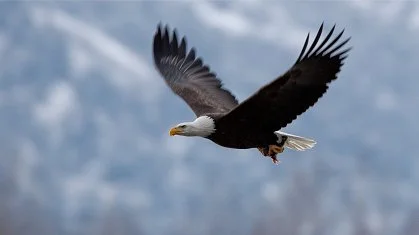Bald Eagle Watching in the
Middle Mississippi River Valley Area
Bald Eagles live near large bodies of open water such as seacoasts, lakes and rivers where there are plenty of fish to eat and tall trees for roosting. There are approximately 2,000 eagles that migrate to the Middle Mississippi River Valley, making the region's overwintering population the second largest in the continental United States behind the Klamath Basin area of southern Oregon and northern California. The area's eagles come mainly from nesting territories in central Canada and the Great Lake states. When the water freezes up north the eagles migrate south to places like the Melvin Price Locks and Dam, the Alton Lake section of the Mississippi River, the Two Rivers National Wildlife Refuge, Pere Marquette State Park, and the Clarksville area where conditions are favorable. The first eagles are usually spotted in December and they migrate back north in March. See the Where to Watch for details on great eagle watching locations.
The Bald Eagle was adopted as the national symbol of the United States in 1782 because of its independence and strength. Measuring about 30 inches (76 cm) in length and possessing a wingspan of 72-84 inches (1.8-2.1 m), the adult eagle is easily identified by its unmistakable brown body set off by a white head and tail and bright yellow bill. The immature bald eagle lacks the white head and tail and has varying amounts of white spotting over its body, tail and underwings.
Despite its fierce image, this eagle is actually quite timid and opportunistic. The eagle's primary prey is fish, although it will also take some small mammals, waterfowl, snakes and carrion, especially during winter. Bald eagles weigh 8-14 pounds (3.6-6.4 kg), with the female larger and heavier as is typical in most birds of prey. "Bald" comes from Old English word "balde" meaning "white headed," not hairless or featherless as is often thought.
Bald eagles were once very common throughout most of the United States. Their populations reached upwards to 500,000 in the early 1700's. Their population levels fell to threatened levels of 10,000 nesting pairs in the 1950's and endangered levels of less than 500 nesting pairs in the 1960's. These population decreases were caused by man with mass shootings, use of crop pesticides, destruction of habitat and contamination of waterways and food sources as prime causes for the eagles' plight.
In Illinois, Bald eagles are seen primarily near large rivers, reservoirs and waterfowl refuges. They spend their days perched in large trees along shorelines, riding chunks of river ice, searching for fish churned up by river vessels or dams, and kettling (soaring) the thermals. In the late afternoons and at night they usually retreat into sheltered valleys and ravines. In the winter, eagles will roost communally in contrast to the territorial nature they exhibit during the breeding season. If an eagle builds a nest, it will stay in the area and won't migrate back north. Currently in Illinois there are approximately 40 active nests compared to 6 in 1990. There is one known active nest the the Meeting of the Great Rivers Scenic Byway area which is located in the Two Rivers National Wildlife Refuge.
Bald eagles were officially declared an endangered species in 1967 in all areas of the United States south of the 40th parallel, under a law that preceded the Endangered Species Act of 1973. Federal and state government agencies, along with private organizations, successfully sought to alert the public about the eagle's plight and to protect its habitat. The 1972 ban on DDT has enabled eagles and other birds of prey to once again begin producing young. Unfortunately, recent extensive human use within preferred eagle habitats has resulted in disturbance and reproductive failure and abandonment of important areas.
In 1994, the bald eagle was reclassified from "endangered" to "threatened" in the lower 48 states. There are currently about 4,500 nesting pairs and 20,000 total eagles in the lower 48 states. Although they have made an encouraging comeback, only public awareness of their situation, strict enforcement of protective laws, preservation of their habitat and support for environmental conservation programs can ensure a successful future for our national symbol.










